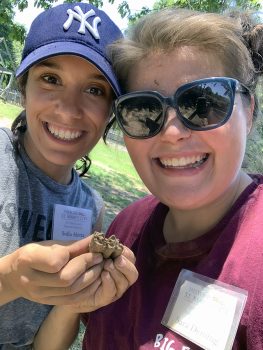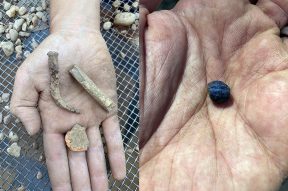Back to Dispatches from Field School
Field School 2019 – Week 6
Sara Deming — Salisbury University
“Goodbye Mill Field, Hello Calvert House Site”

Blog post author Sara Deming (right) with her unit partner, Sofia Aletta, holding a tooth discovered in their excavation unit
It’s Week Six of field school and our first week excavating at the Calvert House site! While working in the Mill Field was fun and exciting, moving to the Calvert House site will be a brand new adventure, filled with new challenges and good times. The Calvert House site is located in Town Center which means we will be interacting with the public more frequently and we are tasked with giving tours of our site. This will be a fun challenge; on one hand public speaking is not my favorite thing to do, but on the other hand, educating and sharing history with others is an important part about being an archaeologist and historian.
As well as being located in Town Center, the Calvert House site has a long history of settlement which gives the site a unique collection of material culture. The site is situated near multiple bodies of water which makes it a desirable location, as well as being on high ground. Native Americans and English colonists alike settled here and the site was occupied throughout the 19th century. Moreover, because the site was occupied by multiple groups, the land was used in different ways by each group. These differences can be seen in the archaeological record through the stratigraphy of the soil. The artifact assemblages also represent the different groups who have lived and shaped the landscape of the Calvert House site.
My unit mate Sofia and I are excavating in a unit which had previously been partially dug but was backfilled (refilled with soil). We have found a wide variety of artifacts, the predictable bricks and nails, coal, some oyster shells, and flakes which were created during the production of stone tools. We have also found animal teeth, bits of porcelain, a piece of North Devon ceramic, and many pipe stems. We even found a portion of a terracotta pipe stem! My favorite artifact that we excavated was a bi-faced projectile point made from quartzite! It was still decently sharp along the edges and heavier than I expected it to be. Another amazing find that another field school student found was a blue glass bead! The soil that were excavating in our unit is dense and dry which makes excavations difficult but our unit is the unit that keeps on giving. I am looking forward to completing more excavations in the unit!

Various artifacts found in Sara and Sofia’s excavation unit. Left: iron nail, ceramic tobacco pipe stem, and brick fragment; Right: blue glass bead
This week we took an afternoon off from digging and attended a lecture on cultural resource management given by Craig Lukezic. This lecture was very informative. I learned about alternative career paths for archaeologists and about how historical architecture goes through the process of being deemed a historical building. It was also refreshing to learn about archaeologists can partake in the cultural side of anthropology rather than just focusing on the material culture.


